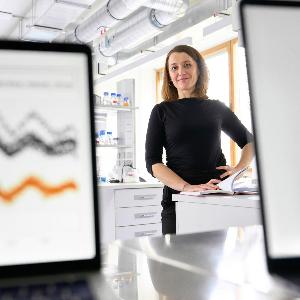Tags, tissues and timing
30 Aug 2021
LMU biologist Maria Robles studies how biological clocks control metabolic states by modifying the structures and activities of specific sets of proteins in cells.
30 Aug 2021
LMU biologist Maria Robles studies how biological clocks control metabolic states by modifying the structures and activities of specific sets of proteins in cells.

"It has long been known that long-term alterations in our daily routines have a negative effect on health,” says Maria Robles. | © LMU / Jan Greune
The origins of chronobiology go back to a wartime bunker in Andechs to the southwest of Munich, which was the site of a long-term and ground-breaking experiment. Over the course of many years, some 400 volunteers each spent several weeks alone, in complete isolation, in a small apartment (the bunker was soon replaced by a dedicated Sleep Laboratory). During their stay, they had no contact with others, never saw the light of day and were effectively cut off from the outside world – so they had no means of telling the time. Nevertheless, they were instructed to follow a regular daily routine, with three meals and ‘normal’ sleep phases. Surprisingly, they managed to maintain such a routine, although most of them tended to get up slightly later each day.
Thanks to experiments such as this, by the 1980s it was clear that humans possess an internal clock. Chronobiologists refer to it as a circadian clock (the term derives from the Latin for ‘approximately’ and ‘day’). In most cases, its cycle time is a little longer than the Earth’s rotation period, around 25 hours. Periods of less than 24 h are rare. Because the clock is set primarily by light, our bodies adapt to the 24-h period. In fact, virtually all cells have their own clocks – and this has probably been the case for billions of years. The evidence suggests that the circadian clock is the product of an early phase in biological evolution. Even unicellular organisms have one. For example, dinoflagellates – an ancient lineage of single-celled, marine organisms – rise to the surface an hour before dawn, in good time to begin the daily round of photosynthesis. Shortly before sunset they “drop off” again.
Ever since the advent of industrialization, sleep has been – unjustifiably – regarded as a waste of time and a sign of culpable laziness.Prof. Maria Robles
This example demonstrates that circadian rhythms are not simply a freak of nature. On the contrary, Maria Robles, Professor of Chronobiology at LMU, is convinced that we too would be well advised to follow their lead in our own daily schedules. She wonders how colleagues and anyone skimp on sleep to improve their productivity. “Ever since the advent of industrialization, sleep has been – unjustifiably – regarded as a waste of time and a sign of culpable laziness,” she says.
With innovations such as artificial lighting, night shifts, long evenings watching TV, night-time surfing sessions on the Internet, H. sapiens makes every effort to run the clock into the ground – and pays a high price for it. As Robles emphasizes, “countless studies have shown that ignoring the dictates of our circadian clock can have negative effects on health”. Long-term perturbation of our innate biological rhythms – caused by shiftwork, for instance – is a risk factor for obesity, diabetes, cancer, cardiovascular disease and depression among others.
So why does it matter when we sleep, eat or work? Convincing answers to this question are hard to come by. “Much of the work in this area has focused on epidemiological and behavioral studies,” Robles says, as researchers have focused on the phenomenon as a whole. But these approaches ignore the fact that each cell has its own clock, which controls its biological functions by regulating which proteins are active at a given time.
Robles is one of the leaders in the field of circadian proteomics, which focuses on cataloguing the sets of proteins present in different cell types using mass spectrometry. This technique allows to track temporal changes in the concentration of all the proteins in a single cell or a particular tissue. Not only that, it can determine where they reside within cells, and what chemical modifications they bear. – And this last factor is what modulates their biochemical activities.
Robles and her group have shown that ‘phosphorylation’ is a central element in the function of cellular circadian clocks. The term refers to the (reversible) attachment of chemical tags called phosphate groups to proteins, and the process has long been known to play a vital role in regulating the activities of proteins. “We found that approximately 25% of all the proteins in liver cells in mice undergo daily cycles of phosphorylation and dephosphorylation. In other words, their activities change periodically in accordance with the time of the day,” she explains. Her team has documented some 2000 phosphorylation states of proteins in mouse liver. “The process is comparable to powering up your computer in the morning before you start to work, and turning it off again every evening.
These results show that the liver, our central metabolic organ, operates in different ways at night and during the day. For the changes in phosphorylation patterns have an impact not only on individual proteins, but on the regulatory circuits in which they are involved. One potential consequence is that food is metabolized in different ways depending on when we eat – and that drugs are more, or less, effective at certain times than others.
The activities of proteins in tissues and organs other than the liver are also subjected to circadian control. In the nervous system, the switch is particularly notable during transitions between the sleep phase and the waking state. In collaboration with colleagues at the University of Zürich, Robles has studied the proteins found in synapses in mice. Synapses are the contact sites that control the processing and transmission of information between neurons. The study demonstrated that patterns of synaptic protein modification underwent particularly significant changes at two times of the day. One is in the late evening, when sleep pressure rises and fatigue comes up. The second round is triggered when it’s time to wake up and be active.
Notably, the alterations that occur in this latter phase activate proteins that enhance synaptic function, and therefore improve interneuronal communication during the day. In the evening, the system is reset: neuronal function is dampened and neurons have a chance to relax and recuperate.
Robles and the members of her group then went on to look at phosphorylation states in the mouse brain. Here too, they found clear differences between patterns of modification seen in cells harvested at night and during the day. As in liver cells, around 2000 proteins showed changes in phosphorylation, with concomitant changes in their activity in the late evening and early morning hours.
So what happens when mice are deprived of sleep? “Lack of sleep disrupts the whole system,” says Robles. Indeed, it affects both the amounts and phosphorylation states of proteins that normally undergo modification. Interestingly, most of the genes that code for these proteins are still expressed. So the mRNAs that direct their synthesis are produced. But these mRNAs fail to produce proteins. Moreover, phosphorylation patterns are altered by sleep deprivation. Together, these perturbations could have significant effects on brain function. Not only does neural replenishment take place in the brain while we sleep, so does the updating of memories and the consolidation of learning.
“It has long been known that long-term alterations in our daily routines have a negative effect on general health,” says Robles. To find out why, subjects on a normal schedule must be compared with individuals who are out of step with the internal clock. “In the latter case, both sleep patterns and eating behavior may be affected,” says Robles. Clearly, it we eat at any and all times, we very probably eat more than we otherwise would. But perhaps the timing of mealtimes – and how the body processes what we eat – also makes a difference.
Don’t try to fight your circadian clock. You have a lot to gain from it.Maria Robles
Robles hopes that her work will one day become part of general medicine. "It is perfectly obvious to me that drugs will work differently depending on when we take them", she says. After all, her research on circadian rhythms in the liver convincingly shows the functional changes in the organ over the course of the day. But clinical tests and operations too are probably best carried out at particular times. Since our internal clocks regulate bodily functions in a circadian fashion, it conceivable that it also has an effect on the results of diagnostic procedures – or how well patients recover from surgery. From a chronobiological standpoint, rousing patients in the early hours of the morning to check their temperatures and get them ready for the daily routine might not be a very good idea.
“It certainly won’t be easy to incorporate this mode of thinking into clinical routines,” Robles admits. It would entail a complete restructuring of procedures – and would probably make them more complicated. With respect to their internal clocks, no two patients are fully in synchrony. Meanwhile, however, all of us can take steps to ensure that we turn in at around the same time every night and get enough sleep. And as far as possible, phases of activity and mealtimes should be scheduled for daylight hours. “Don’t try to fight your circadian clock,” Robles advises. “You have a lot to gain from it.”
Text: Stefanie Reinberger
Prof. Dr. Maria Robles is Professor of Systems Chronobiology at the Institute of Medical Psychology at LMU. Robles (born 1974 in Spain) studied Biology at the Universidad de León, and obtained her PhD at the Universidad Autónoma de Madrid. She went on to do postdoctoral research at Harvard Medical School in Boston, before moving to the Max Planck Institute for Biochemistry in Martinsried as a Marie Curie Research Fellow and Project Leader. She was appointed to her present position at LMU in 2017.

Read more articles on the topic of "crises" in the current issue of "INSIGHTS. Magazine".
You can also read selected stories in the online section of INSIGHTS.